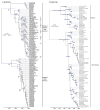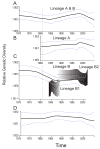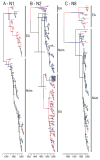Gene flow and competitive exclusion of avian influenza A virus in natural reservoir hosts
- PMID: 19501380
- PMCID: PMC2753668
- DOI: 10.1016/j.virol.2009.05.002
Gene flow and competitive exclusion of avian influenza A virus in natural reservoir hosts
Abstract
Geographical separation of host species has shaped the avian influenza A virus gene pool into independently evolving Eurasian and American lineages, although phylogenetic evidence for gene flow and reassortment indicates that these lineages also mix on occasion. While the evolutionary dynamics of the avian influenza gene pool have been described, the consequences of gene flow on virus evolution and population structure in this system have not been investigated. Here we show that viral gene flow from Eurasia has led to the replacement of endemic avian influenza viruses in North America, likely through competition for susceptible hosts. This competition is characterized by changes in rates of nucleotide substitution and selection pressures. However, the discontinuous distribution of susceptible hosts may produce long periods of co-circulation of competing virus strains before lineage extinction occurs. These results also suggest that viral competition for host resources may be an important mechanism in disease emergence.
Figures




References
Publication types
MeSH terms
Substances
Grants and funding
LinkOut - more resources
Full Text Sources
Medical

